
Photo from wikipedia
Abstract In electrocoagulation, the accumulation of gas bubbles surrounding the electrode plate surface results in high internal resistance between the electrode plates that obstruct optimum ionic transfer, subsequently reducing the… Click to show full abstract
Abstract In electrocoagulation, the accumulation of gas bubbles surrounding the electrode plate surface results in high internal resistance between the electrode plates that obstruct optimum ionic transfer, subsequently reducing the electrocoagulation efficiency. This study investigated the performance of batch electrocoagulation designed with vibration-induced electrode plates in the treatment of landfill leachate to remove colour and chemical oxygen demand (COD). The electrode plates in the electrocoagulation cell were each attached with a DC motor vibrator, varied at different vibration intensity in which its effect on the initial pH, operating time and electrical current of the electrocoagulation were determined. The results showed that the application of vibration-induced electrode plates had a synergistic effect with the electrocoagulation with more than 90 % of colour and COD up to 35 % removed during the treatment at vibration intensity of 2.8 V, initial pH 5, operating time of 35 min, applied current of 2.5A (applied voltage ranged between 11.0–12.9 V), with calculated electrical energy consumption of 8.58 kW h/m3. Overall, the vibration-induced electrode plates were found to enhance the treatment performance due to a combination of improved ionic transfer, enhanced bubbles detachment from the electrode surface and dispersion in the solution. The detachment of bubbles from the plates also enable improved mixing in the solution, leading to an increase in homogeneity and better sludge separation following treatment. In conclusion, this study showed that electrocoagulation with vibration-induced electrode plates provided an improved technique in enhancing the ionic transfer and bubbles dispersion in electrocoagulation for the removal of pollutants.
Journal Title: Journal of water process engineering
Year Published: 2020
Link to full text (if available)
Share on Social Media: Sign Up to like & get
recommendations!